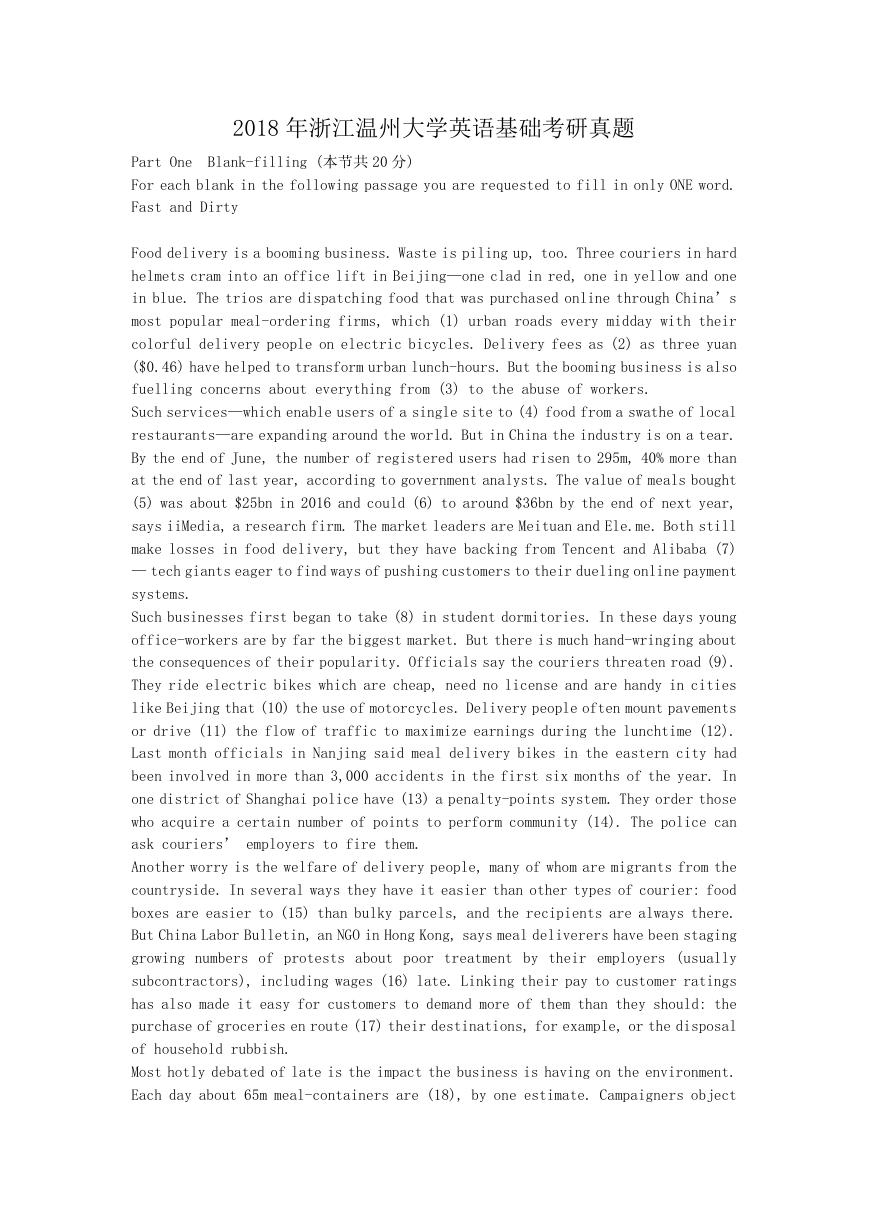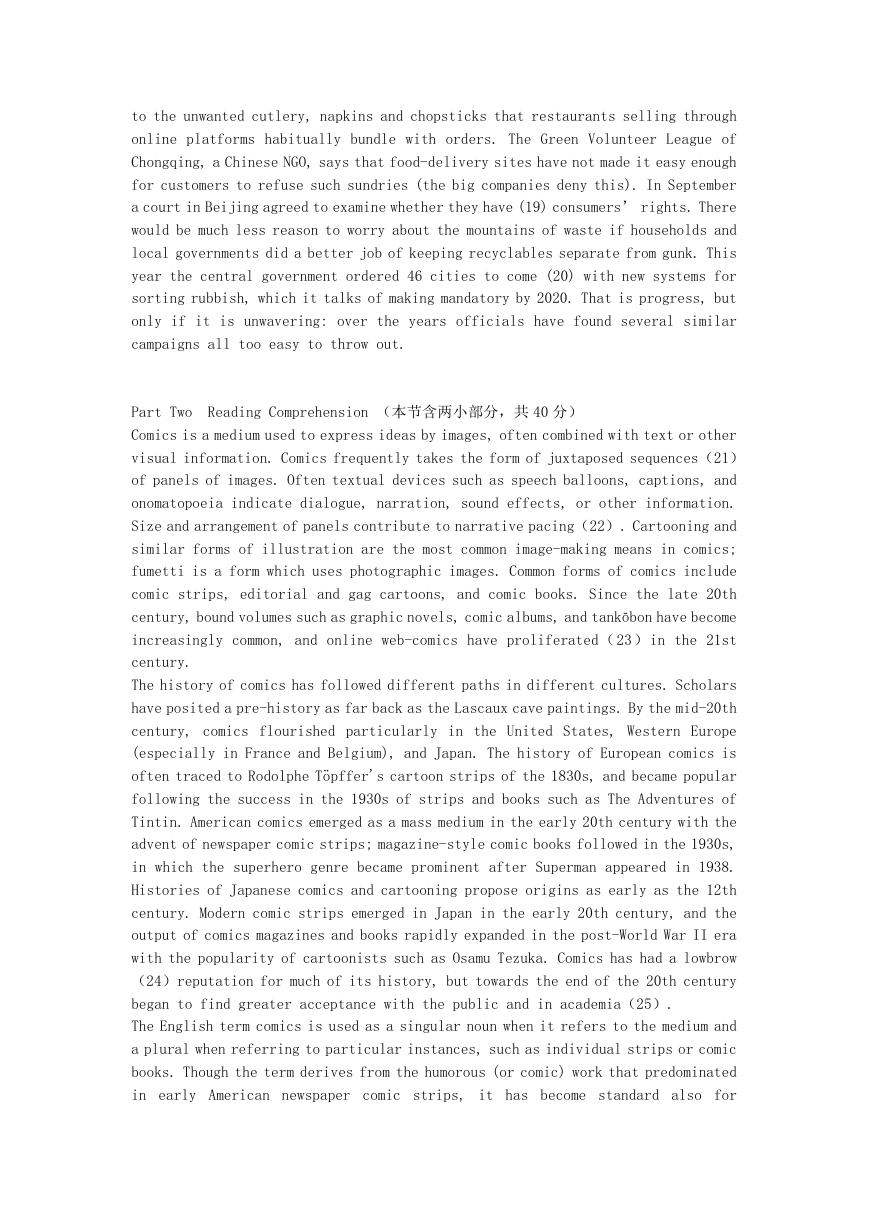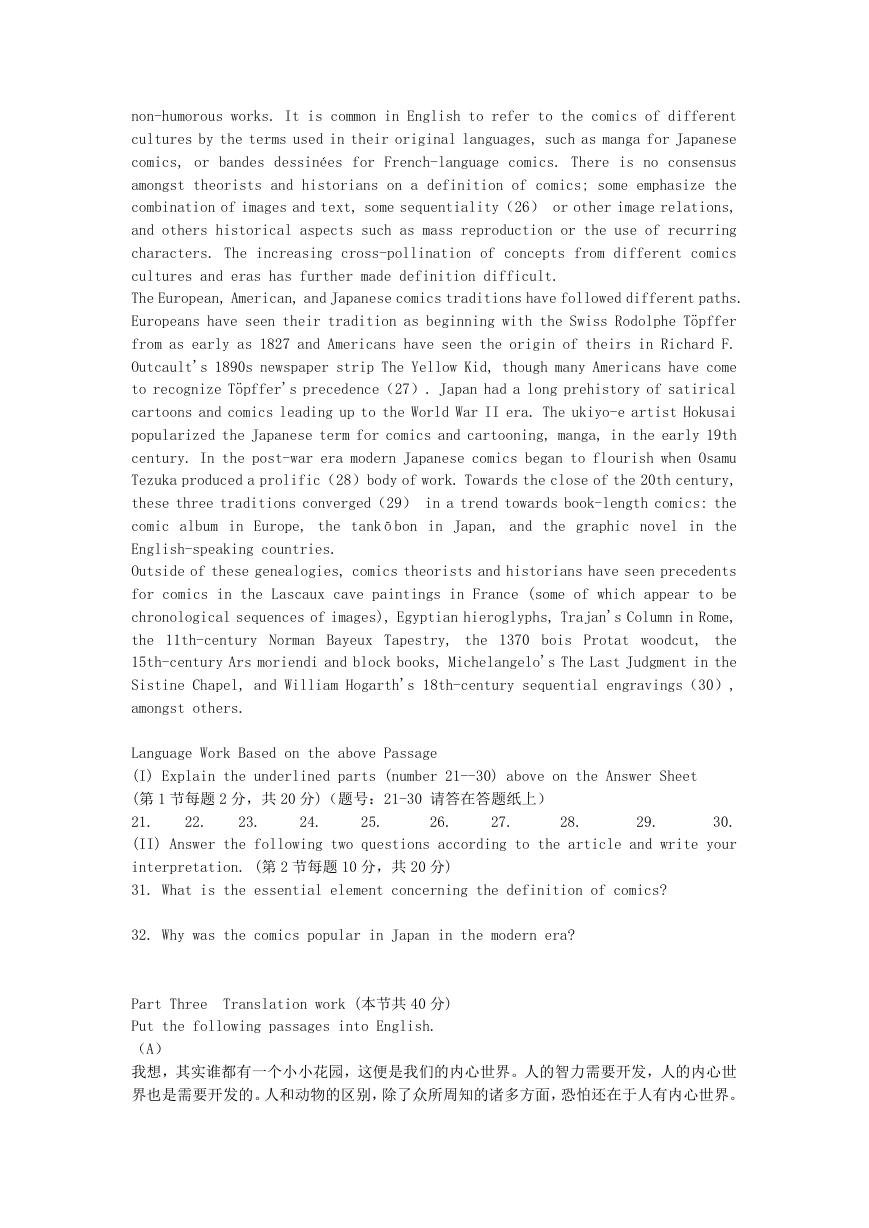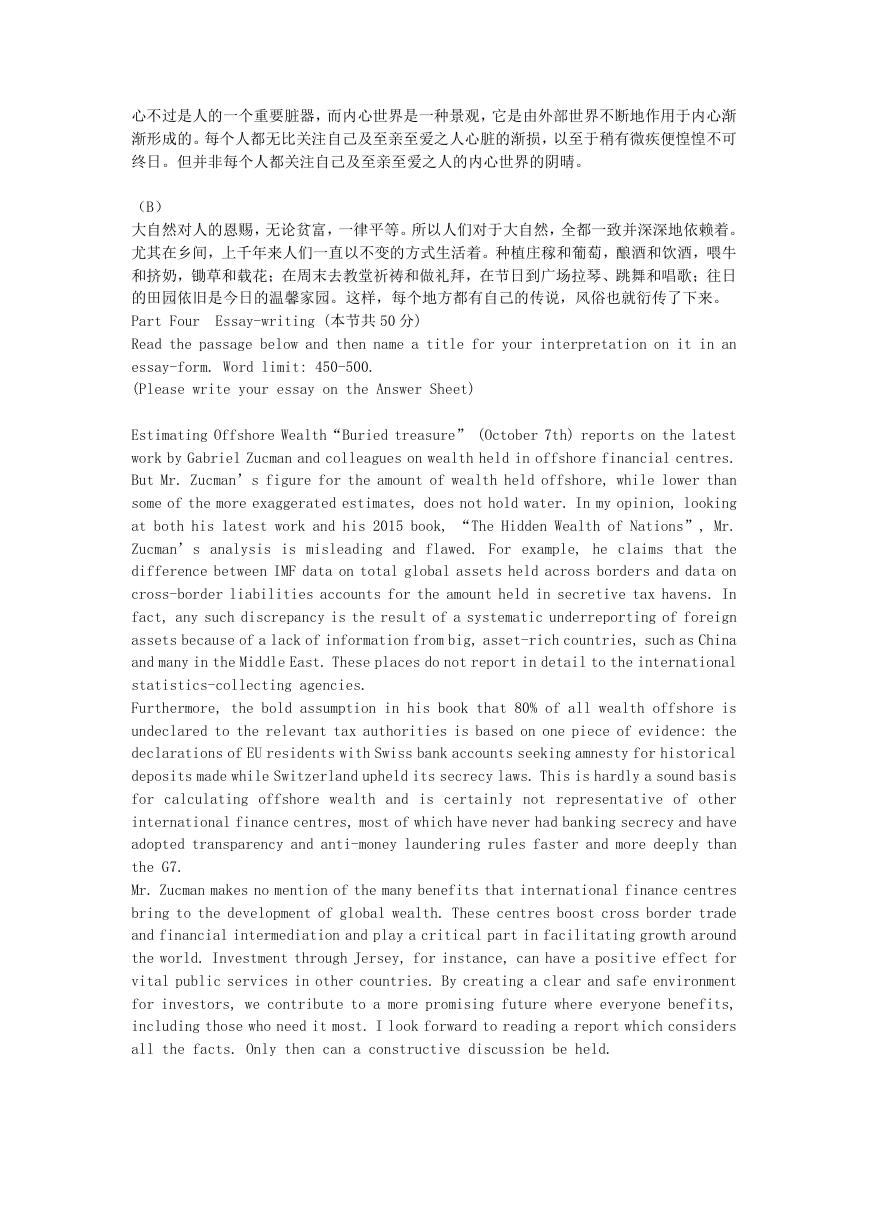2018 年浙江温州大学英语基础考研真题
Part One Blank-filling (本节共 20 分)
For each blank in the following passage you are requested to fill in only ONE word.
Fast and Dirty
Food delivery is a booming business. Waste is piling up, too. Three couriers in hard
helmets cram into an office lift in Beijing—one clad in red, one in yellow and one
in blue. The trios are dispatching food that was purchased online through China’s
most popular meal-ordering firms, which (1) urban roads every midday with their
colorful delivery people on electric bicycles. Delivery fees as (2) as three yuan
($0.46) have helped to transform urban lunch-hours. But the booming business is also
fuelling concerns about everything from (3) to the abuse of workers.
Such services—which enable users of a single site to (4) food from a swathe of local
restaurants—are expanding around the world. But in China the industry is on a tear.
By the end of June, the number of registered users had risen to 295m, 40% more than
at the end of last year, according to government analysts. The value of meals bought
(5) was about $25bn in 2016 and could (6) to around $36bn by the end of next year,
says iiMedia, a research firm. The market leaders are Meituan and Ele.me. Both still
make losses in food delivery, but they have backing from Tencent and Alibaba (7)
— tech giants eager to find ways of pushing customers to their dueling online payment
systems.
Such businesses first began to take (8) in student dormitories. In these days young
office-workers are by far the biggest market. But there is much hand-wringing about
the consequences of their popularity. Officials say the couriers threaten road (9).
They ride electric bikes which are cheap, need no license and are handy in cities
like Beijing that (10) the use of motorcycles. Delivery people often mount pavements
or drive (11) the flow of traffic to maximize earnings during the lunchtime (12).
Last month officials in Nanjing said meal delivery bikes in the eastern city had
been involved in more than 3,000 accidents in the first six months of the year. In
one district of Shanghai police have (13) a penalty-points system. They order those
who acquire a certain number of points to perform community (14). The police can
ask couriers’ employers to fire them.
Another worry is the welfare of delivery people, many of whom are migrants from the
countryside. In several ways they have it easier than other types of courier: food
boxes are easier to (15) than bulky parcels, and the recipients are always there.
But China Labor Bulletin, an NGO in Hong Kong, says meal deliverers have been staging
growing numbers of protests about poor treatment by their employers (usually
subcontractors), including wages (16) late. Linking their pay to customer ratings
has also made it easy for customers to demand more of them than they should: the
purchase of groceries en route (17) their destinations, for example, or the disposal
of household rubbish.
Most hotly debated of late is the impact the business is having on the environment.
Each day about 65m meal-containers are (18), by one estimate. Campaigners object
�
to the unwanted cutlery, napkins and chopsticks that restaurants selling through
online platforms habitually bundle with orders. The Green Volunteer League of
Chongqing, a Chinese NGO, says that food-delivery sites have not made it easy enough
for customers to refuse such sundries (the big companies deny this). In September
a court in Beijing agreed to examine whether they have (19) consumers’ rights. There
would be much less reason to worry about the mountains of waste if households and
local governments did a better job of keeping recyclables separate from gunk. This
year the central government ordered 46 cities to come (20) with new systems for
sorting rubbish, which it talks of making mandatory by 2020. That is progress, but
only if it is unwavering: over the years officials have found several similar
campaigns all too easy to throw out.
Part Two Reading Comprehension (本节含两小部分,共 40 分)
Comics is a medium used to express ideas by images, often combined with text or other
visual information. Comics frequently takes the form of juxtaposed sequences(21)
of panels of images. Often textual devices such as speech balloons, captions, and
onomatopoeia indicate dialogue, narration, sound effects, or other information.
Size and arrangement of panels contribute to narrative pacing(22). Cartooning and
similar forms of illustration are the most common image-making means in comics;
fumetti is a form which uses photographic images. Common forms of comics include
comic strips, editorial and gag cartoons, and comic books. Since the late 20th
century, bound volumes such as graphic novels, comic albums, and tankōbon have become
increasingly common, and online web-comics have proliferated( 23)in the 21st
century.
The history of comics has followed different paths in different cultures. Scholars
have posited a pre-history as far back as the Lascaux cave paintings. By the mid-20th
century, comics flourished particularly in the United States, Western Europe
(especially in France and Belgium), and Japan. The history of European comics is
often traced to Rodolphe Töpffer's cartoon strips of the 1830s, and became popular
following the success in the 1930s of strips and books such as The Adventures of
Tintin. American comics emerged as a mass medium in the early 20th century with the
advent of newspaper comic strips; magazine-style comic books followed in the 1930s,
in which the superhero genre became prominent after Superman appeared in 1938.
Histories of Japanese comics and cartooning propose origins as early as the 12th
century. Modern comic strips emerged in Japan in the early 20th century, and the
output of comics magazines and books rapidly expanded in the post-World War II era
with the popularity of cartoonists such as Osamu Tezuka. Comics has had a lowbrow
(24)reputation for much of its history, but towards the end of the 20th century
began to find greater acceptance with the public and in academia(25).
The English term comics is used as a singular noun when it refers to the medium and
a plural when referring to particular instances, such as individual strips or comic
books. Though the term derives from the humorous (or comic) work that predominated
in early American newspaper comic strips, it has become standard also for
�
non-humorous works. It is common in English to refer to the comics of different
cultures by the terms used in their original languages, such as manga for Japanese
comics, or bandes dessinées for French-language comics. There is no consensus
amongst theorists and historians on a definition of comics; some emphasize the
combination of images and text, some sequentiality(26) or other image relations,
and others historical aspects such as mass reproduction or the use of recurring
characters. The increasing cross-pollination of concepts from different comics
cultures and eras has further made definition difficult.
The European, American, and Japanese comics traditions have followed different paths.
Europeans have seen their tradition as beginning with the Swiss Rodolphe Töpffer
from as early as 1827 and Americans have seen the origin of theirs in Richard F.
Outcault's 1890s newspaper strip The Yellow Kid, though many Americans have come
to recognize Töpffer's precedence(27). Japan had a long prehistory of satirical
cartoons and comics leading up to the World War II era. The ukiyo-e artist Hokusai
popularized the Japanese term for comics and cartooning, manga, in the early 19th
century. In the post-war era modern Japanese comics began to flourish when Osamu
Tezuka produced a prolific(28)body of work. Towards the close of the 20th century,
these three traditions converged(29) in a trend towards book-length comics: the
comic album in Europe, the tank ō bon in Japan, and the graphic novel in the
English-speaking countries.
Outside of these genealogies, comics theorists and historians have seen precedents
for comics in the Lascaux cave paintings in France (some of which appear to be
chronological sequences of images), Egyptian hieroglyphs, Trajan's Column in Rome,
the 11th-century Norman Bayeux Tapestry, the 1370 bois Protat woodcut, the
15th-century Ars moriendi and block books, Michelangelo's The Last Judgment in the
Sistine Chapel, and William Hogarth's 18th-century sequential engravings(30),
amongst others.
Language Work Based on the above Passage
(I) Explain the underlined parts (number 21--30) above on the Answer Sheet
(第 1 节每题 2 分,共 20 分)(题号:21-30 请答在答题纸上)
21.
30.
(II) Answer the following two questions according to the article and write your
interpretation. (第 2 节每题 10 分,共 20 分)
31. What is the essential element concerning the definition of comics?
25.
26.
27.
22.
23.
24.
28.
29.
32. Why was the comics popular in Japan in the modern era?
Translation work (本节共 40 分)
Part Three
Put the following passages into English.
(A)
我想,其实谁都有一个小小花园,这便是我们的内心世界。人的智力需要开发,人的内心世
界也是需要开发的。人和动物的区别,除了众所周知的诸多方面,恐怕还在于人有内心世界。
�
心不过是人的一个重要脏器,而内心世界是一种景观,它是由外部世界不断地作用于内心渐
渐形成的。每个人都无比关注自己及至亲至爱之人心脏的渐损,以至于稍有微疾便惶惶不可
终日。但并非每个人都关注自己及至亲至爱之人的内心世界的阴晴。
(B)
大自然对人的恩赐,无论贫富,一律平等。所以人们对于大自然,全都一致并深深地依赖着。
尤其在乡间,上千年来人们一直以不变的方式生活着。种植庄稼和葡萄,酿酒和饮酒,喂牛
和挤奶,锄草和载花;在周末去教堂祈祷和做礼拜,在节日到广场拉琴、跳舞和唱歌;往日
的田园依旧是今日的温馨家园。这样,每个地方都有自己的传说,风俗也就衍传了下来。
Part Four
Read the passage below and then name a title for your interpretation on it in an
essay-form. Word limit: 450-500.
(Please write your essay on the Answer Sheet)
Essay-writing (本节共 50 分)
Estimating Offshore Wealth“Buried treasure” (October 7th) reports on the latest
work by Gabriel Zucman and colleagues on wealth held in offshore financial centres.
But Mr. Zucman’s figure for the amount of wealth held offshore, while lower than
some of the more exaggerated estimates, does not hold water. In my opinion, looking
at both his latest work and his 2015 book, “The Hidden Wealth of Nations”, Mr.
Zucman’s analysis is misleading and flawed. For example, he claims that the
difference between IMF data on total global assets held across borders and data on
cross-border liabilities accounts for the amount held in secretive tax havens. In
fact, any such discrepancy is the result of a systematic underreporting of foreign
assets because of a lack of information from big, asset-rich countries, such as China
and many in the Middle East. These places do not report in detail to the international
statistics-collecting agencies.
Furthermore, the bold assumption in his book that 80% of all wealth offshore is
undeclared to the relevant tax authorities is based on one piece of evidence: the
declarations of EU residents with Swiss bank accounts seeking amnesty for historical
deposits made while Switzerland upheld its secrecy laws. This is hardly a sound basis
for calculating offshore wealth and is certainly not representative of other
international finance centres, most of which have never had banking secrecy and have
adopted transparency and anti-money laundering rules faster and more deeply than
the G7.
Mr. Zucman makes no mention of the many benefits that international finance centres
bring to the development of global wealth. These centres boost cross border trade
and financial intermediation and play a critical part in facilitating growth around
the world. Investment through Jersey, for instance, can have a positive effect for
vital public services in other countries. By creating a clear and safe environment
for investors, we contribute to a more promising future where everyone benefits,
including those who need it most. I look forward to reading a report which considers
all the facts. Only then can a constructive discussion be held.
�








 2023年江西萍乡中考道德与法治真题及答案.doc
2023年江西萍乡中考道德与法治真题及答案.doc 2012年重庆南川中考生物真题及答案.doc
2012年重庆南川中考生物真题及答案.doc 2013年江西师范大学地理学综合及文艺理论基础考研真题.doc
2013年江西师范大学地理学综合及文艺理论基础考研真题.doc 2020年四川甘孜小升初语文真题及答案I卷.doc
2020年四川甘孜小升初语文真题及答案I卷.doc 2020年注册岩土工程师专业基础考试真题及答案.doc
2020年注册岩土工程师专业基础考试真题及答案.doc 2023-2024学年福建省厦门市九年级上学期数学月考试题及答案.doc
2023-2024学年福建省厦门市九年级上学期数学月考试题及答案.doc 2021-2022学年辽宁省沈阳市大东区九年级上学期语文期末试题及答案.doc
2021-2022学年辽宁省沈阳市大东区九年级上学期语文期末试题及答案.doc 2022-2023学年北京东城区初三第一学期物理期末试卷及答案.doc
2022-2023学年北京东城区初三第一学期物理期末试卷及答案.doc 2018上半年江西教师资格初中地理学科知识与教学能力真题及答案.doc
2018上半年江西教师资格初中地理学科知识与教学能力真题及答案.doc 2012年河北国家公务员申论考试真题及答案-省级.doc
2012年河北国家公务员申论考试真题及答案-省级.doc 2020-2021学年江苏省扬州市江都区邵樊片九年级上学期数学第一次质量检测试题及答案.doc
2020-2021学年江苏省扬州市江都区邵樊片九年级上学期数学第一次质量检测试题及答案.doc 2022下半年黑龙江教师资格证中学综合素质真题及答案.doc
2022下半年黑龙江教师资格证中学综合素质真题及答案.doc